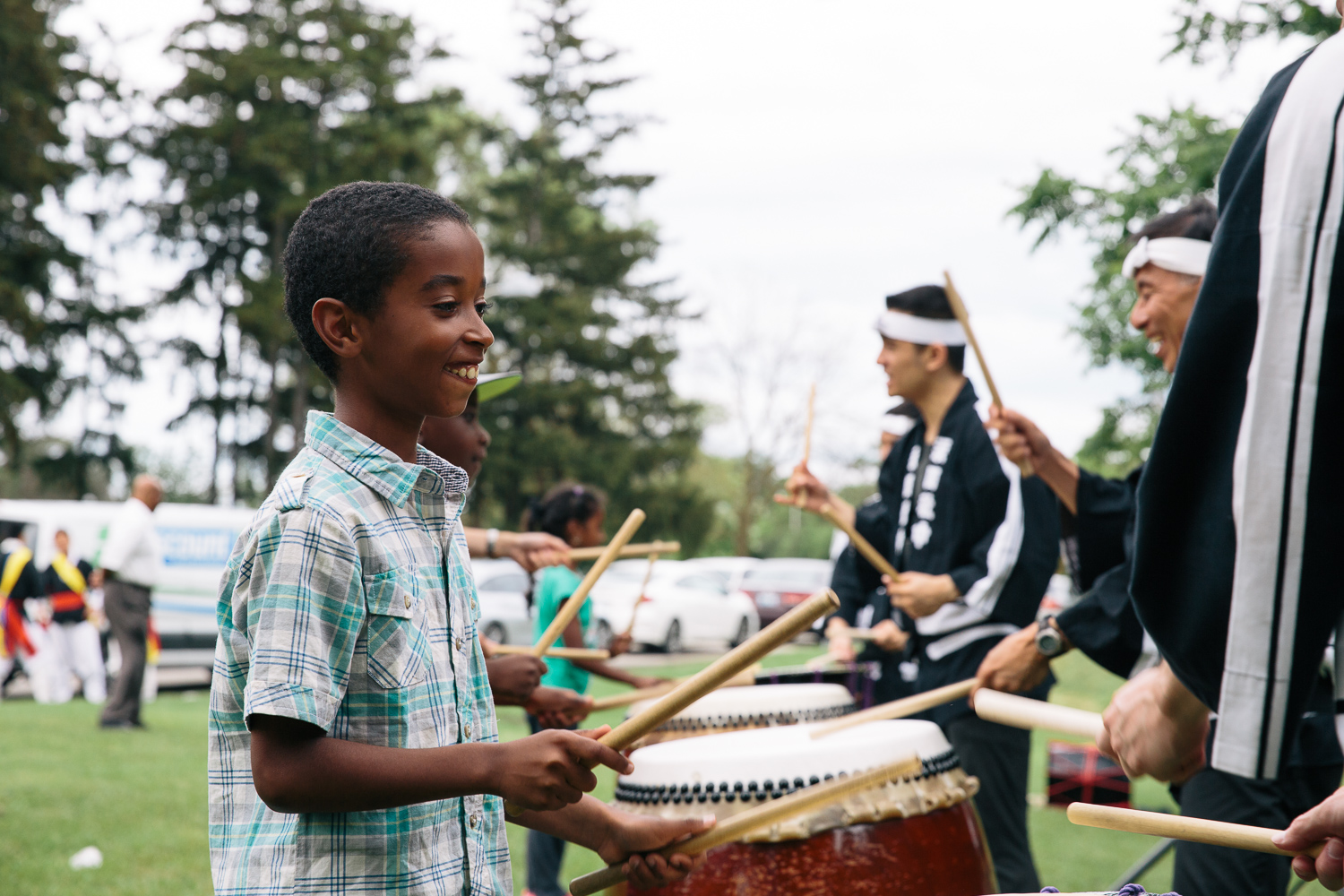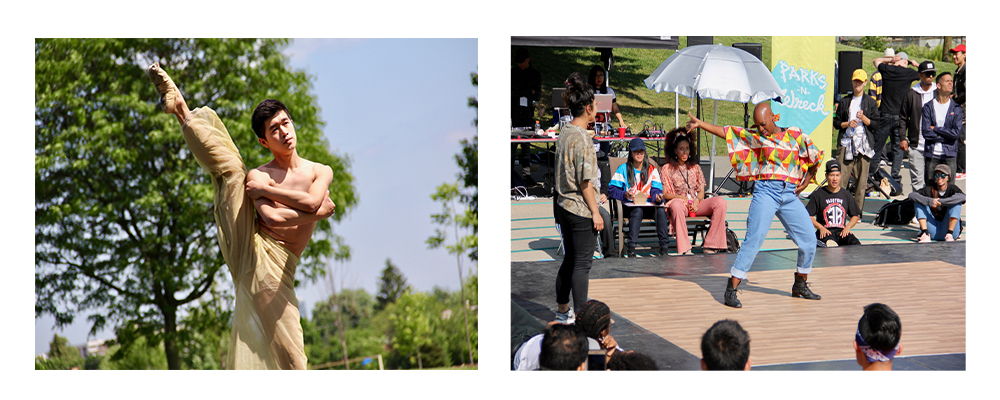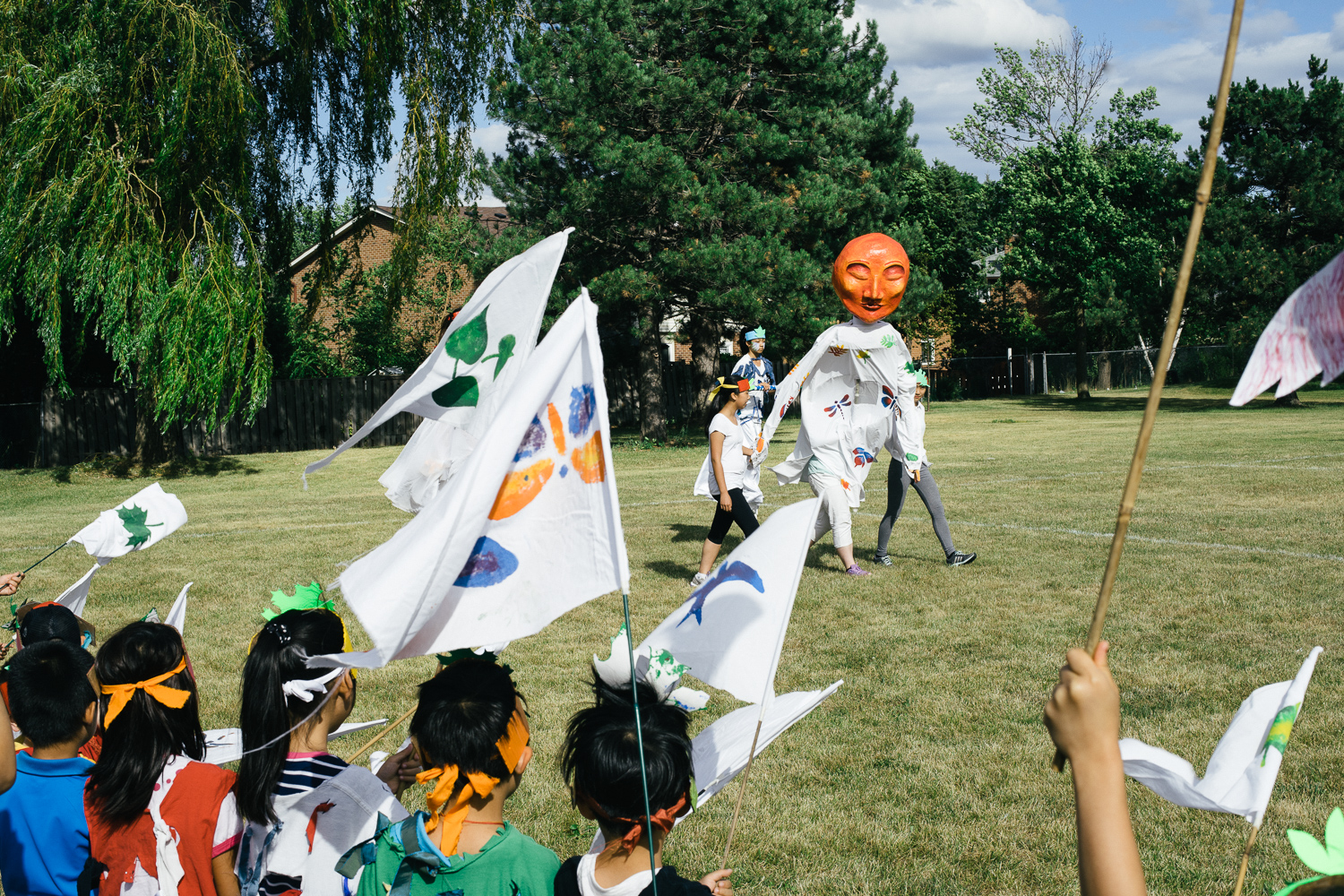Animating Toronto Parks: A Bridge Between Artists and the City, A Matchmaker Between Artists & Parks
 Special feature by Sabrina Fields, Communications Intern
Special feature by Sabrina Fields, Communications Intern
 Boy with drums: Nagata Shachu and Ensemble Jeng Yi present Toronto Taiko Tales at Panorama Park. Photo courtesy of Sean Howard.
Boy with drums: Nagata Shachu and Ensemble Jeng Yi present Toronto Taiko Tales at Panorama Park. Photo courtesy of Sean Howard.
An exciting opportunity for artists to participate in community building.
It’s a beautiful day in the neighbourhood and a busy day for Toronto Arts Council Grants Officer, Erika Hennebury as she preps for the annual incoming of applications for Animating Toronto Parks – a grant program providing funding for various artists, art collectives, and art organizations to ensure they have the resources and space to showcase their professional arts projects through Arts in the Parks.
Entering it’s 3rd year in 2018, Arts in the Parks is an initiative of the Toronto Arts Foundation that brings free arts events to various Toronto Parks throughout the summer.
The deadline to apply for Animating Toronto Arts is December 4, 2017. For more information please visit http://www.torontoartscouncil.org/grant-programs/tac-grants/animating-toronto-parks If you have any questions about the process please contact Erika Hennebury at her email erika@torontoartscouncil.org
How The Idea Emerged
Animating Toronto Parks was conceived out of the concern from artists who expressed facing barriers accessing funding to display their work publicly, and the general lack of infrastructure to share their work through readily available public park spaces. To be responsive to these concerns, Toronto Arts Council decided to build a bridge between artists and parks. Animating Toronto Parks and Arts in the Parks were born in tandem, to allow for artists to apply for funding (through Animating Toronto Parks) and then have the support and structure to deliver their art projects (through Arts in the Parks).
For Hennebury, Animating Toronto Parks encapsulates the central vision of Toronto Arts Council: creative city block by block. She explains, “it is really a vision about thinking of the city as a whole and making sure we’re not missing anyone. Because a lot of the funding tends to be concentrated to the downtown core of the city and there is less cultural infrastructure in the inner suburbs and fewer artists being funded in the inner suburbs.” For this reason Animating Toronto Parks focuses on parks that are mostly located in Etobicoke, North York, and Scarborough.
 Left. Little Pear Garden Dance Company. Photo courtesy of Josh Clavir. Right. Parks N’ Wreck. Photo courtesy of Josh Clavir.
Left. Little Pear Garden Dance Company. Photo courtesy of Josh Clavir. Right. Parks N’ Wreck. Photo courtesy of Josh Clavir.
What The Jurors Are Looking For
Assessing which applications will get supported is done by a peer review jury comprised of fellow artists from diverse cultural backgrounds, artistic backgrounds and parts of the city. The jurors look for the following three principles during adjudication: artistic merit; feasibility of the project; and capacity for the artist, collective, or organization to execute the project. They assign each project a score, and then meet back with Hennebury to come to a consensus about which ones qualify for funding.
Jurors do not choose the best application based strictly on artistic standpoint, but rather programming that offers the community a unique and engaging experience.
The jury plays the role of matchmaker between the parks and the artists and ensures meaningful community engagement of both artists and the communities they serve.
Connecting Artists With Parks
Animating Toronto Parks is always seeking applications from artists who have not been a part of Arts in the Parks in the past, as well as welcoming to returning artists and arts organizations/collectives. In fact, Hennebury sees a lot of value in returning projects, saying “it’s wonderful when recurring programs are funded because getting to know a community is a long term project.” Building sustainable relationships with communities is made possible through a partnership with a local group who advocate for Toronto’s parks, Parks People. Parks People have been working across the city for the past few years to create a “Friends of Parks Group” in over one hundred different parks.
“There can be a lot of really nice symbiotic relationships that come out of this and relationships that can last years and years. Like we have some groups that have made beautiful connections with their Park Friends Group that they’ve come back to the same park year after year, to continue the project and continue building those relationships.” - Erika Hennebury
 Shadowland Theatre presents The Spirit of our Park at Alexmuir Park, 2016. Photo courtesy of Sean Howard.
Shadowland Theatre presents The Spirit of our Park at Alexmuir Park, 2016. Photo courtesy of Sean Howard.
The first thing Animating Toronto Parks does after selecting a project is introducing them to the “Friends of Parks Group” so artists can get to know the neighbourhood they will be presenting in. Hennebury notes, “there can be a lot of really nice symbiotic relationships that come out of this and relationships that can last years and years. Like we have some groups that have made beautiful connections with their Park Friends Group that they’ve come back to the same park year after year, to continue the project and continue building those relationships.” She continues by giving an example of Shadowland Theatre presenting in Alexmuir Park in Scarborough over the past couple of years.
Shadowland Theatre also made a personal connection with the Rosewood Taxpayers’ Association, who in-turn helped them out by creating access to a bathroom at someone’s house in the park, where a washroom space is not readily available, and also by giving them space in a local garage to hold materials.
Step-by-Step Breakdown of the Application Process
So how can you apply to be part of Arts in the Parks through Animating Toronto Parks? Hennebury has broken it down into four simple steps.
Step One: Carefully read the guidelines and park descriptions. This may seem obvious but it’s really important for artists to be able to understand the program to accurately determine if the project they have in mind is a good fit for this initiative.
Step Two: Read the parks description and think about what parks you are interested in working in. It’s not as simple as picking a park and rolling with it, artists have to research potential community partners and establish community engagement plans in their application and therefore location is a crucial element.
Step Three: Contact Erika Hennebury before applying to discuss the project; she also gives applicants feedback so they can put their best application forward. She can be reached at erika@torontoartscouncil.org
Step Four: Fill out the online application before the deadline December 4, 2017. You can access the application through the following link: http://www.torontoartscouncil.org/grant-programs/discover-tac-grants/online-application